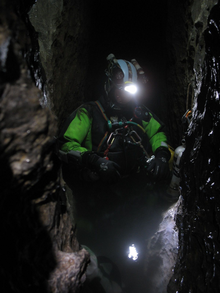Dive light

Cave diver with head-mounted light
|
|
| Uses | Providing light underwater for safety, navigation, communication, facilitating work or restoring colour |
|---|---|
A dive light is a light source carried by an underwater diver to illuminate the underwater environment. Scuba divers generally carry self-contained lights, but surface supplied divers may carry lights powered by cable supply .
A dive light is routinely used during night dives and cave dives, when there is little or no natural light, but also has a useful function during the day, as water absorbs the longer (red) wavelengths first then the yellow and green with increasing depth. By using artificial light, it is possible to view an object in full color at greater depths.
Water is responsible for the attenuation of light due to absorption so use of a dive light will improve a divers underwater vision. As the depth increases, more light is absorbed by the water. Color absorption depends on the purity of the water - pure water is most transparent to blue frequencies, but impurities may reduce this significantly. Color vision is also affected by turbidity and larger particulate matter.
Early underwater lights were fixed electric flood lamps or portable lamps with dry batteries for use by divers in standard diving dress.Siebe Gorman & Company Ltd developed a model of portable lamp with a parabolic lens and attached to the divers corselet via a ball and socket joint allowing the diver to use both hands while working.
In 1906, the tungsten filament was introduced and used to produce 200 to 3,000 candlepower dive lights. The Siebe Gorman & Company introduced a 250-watt mercury vapor hand lamp in 1919 that could produce as much as 18,000 candles. For diving in turbid water, 45-watt Sodium hand lamps became the preferred choice. These early lights had to be turned on underwater to avoid cracking the heated glass as it entered cold water.
The first lantern available to the US Navy had 150 candlepower. The early testing showed a need to increase the length of cable on the US Navy Standard Lantern from 125 feet to 250 feet in 1915 to allow for greater operational range. The United States Navy Experimental Diving Unit continues to evaluate dive lights for wet and dry illumination output, battery duration, watertight integrity, as well as maximum operating depth.
...
Wikipedia
